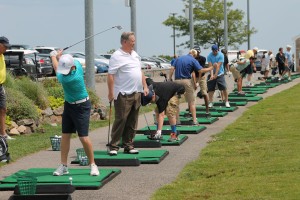As any golfer knows, the time they spend practicing the different areas of their game can prove to be very rewarding. But many golfers will go to the range for a day and aimlessly beat golf balls till sunset, believing that they have somehow helped their golf game. That style of practice will make a golfer stagnant in their game, and will cause a great deal of frustration. Without any practice routine or a set of goals to accomplish during a practice session, you will have a hard time finding much improvement.
Throughout the course of my career as a competitive golfer, I have learned many things about practicing golf. The things that I have learned from various coaches, professionals, and instructors have helped me become a better golfer not only on the course, but in my practice as well. While I may not be an ‘expert’ on this topic, I hope to share some of the things that I have learned about practice, and that they can be helpful to anyone looking to improve their quality of practice on the golf course.
 Quality over quantity
Quality over quantity
It cannot be stressed how important it is to avoid thumping a bucket of range balls in a quick and sloppy routine. I have seen plenty of golfers hit a handful of balls in a matter of a few seconds, as if the balls in front of them were going to explode if they didn’t hit them in time. When a golfer is hitting range balls, they aren’t just practicing the swing, they are practicing a routine. Use that routine in every shot taken at the range, and it will feel more and more comfortable out on the course.
Swing a variety of clubs
Another mistake I commonly see when practicing is a golfer who has only brought one club out to the range with them. Most commonly that club is a driver. We all love to bash the driver (who doesn’t)? But swinging just one club will not be beneficial for the majority of your game. A swing with a driver is a lot different than a swing with a 7 iron, or a sand wedge. Since most clubs in a golf bag have different lengths, those different lengths will call for different swings. To improve your whole full swing, one must hit a variety of clubs.
Don’t overload the swing thoughts
After a lesson, most of the time your instructor will give you a list of things to work on. Depending on how often you practice before the next lesson, it may not be the best idea to practice all of those things on the list in one session of practice. Trying to improve in too many areas of the swing at one time will lead to confusion and frustration. When you are out at the range after a lesson, try to work on only one or two things for that day. Keep things simple, and in return, your golf swing will steadily improve.
 Find a few practice partners
Find a few practice partners
If you have ever watched a horse race, you will notice that the horses will run their fastest when they notice another horse is trying to pass them. We golfers have a similar mentality. No matter what goals you are trying to achieve in your golf game, finding golfers at a similar skill level to practice with will help encourage you to achieve those goals. Whether it is putting a few dollars down on a putting contest or a closest-to-the-pin contest for a Coke, those practice competitions can help prepare a golfer for whatever situations may arise out on the golf course.
More practice green, less range
Every golfer has their limit to how many golf balls they can hit in one practice session. That limit is different for everyone, and it is crucial for them to understand what that limit is. Going too far over that limit can lead to poor swing habits, fatigue, and injuries. Once you have hit your limit of range balls, it’s crucial that you work on your short game as well. Many golf professionals say you should almost spend more time around the practice green than you do on the range. Considering that 65% of the game takes place inside 125 yards, it seems very reasonable that short game should be practiced the most. Chipping and putting is almost always the easiest way to knock a few strokes off of your game. Personally, I found that once I devoted a good amount of time to my short game, I saw a breakthrough in my tournament scores. So the next time you find yourself practicing, make sure you set aside some time on the practice green.
I hope that this article has been helpful, and that you can use something from this article for your next practice session. Remember, practicing golf will never make perfect, but perfect practice can help build consistency and confidence in every area of your golf game.
**Chris Johnson is a student at Iowa State University, member of the ISU club golf team, and guest writer for Nextgengolf.



